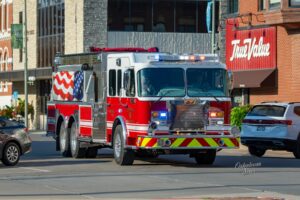Oskaloosa Fire Department Adds New Engine 75 to Fleet
OSKALOOSA, Iowa — The Oskaloosa Fire Department has placed a new fire engine into service, replacing two aging trucks with one modern apparatus designed and built in Iowa.
The new rig, known as Engine 75, arrived in August and was immediately put into operation. Manufactured by Toyne Fire Apparatus in Breda, the pumper/tanker combines the capabilities of both a water tanker and a traditional pumper. It carries 3,000 gallons of water, seats a crew of six firefighters, and is equipped with a 1,500-gallon-per-minute pump.
Replacing Two Older Trucks
Engine 75 takes the place of a 1996 tanker and a 2000 pumper, both of which had been in service for decades. By consolidating those vehicles into one, the department reduces maintenance costs while improving efficiency. The truck also includes a 3,000-gallon portable tank, mounted on a hydraulic rack, which will support rural firefighting operations where hydrants are not available.
Council Approval and Delivery
The purchase was approved earlier this year by the Oskaloosa City Council, which authorized the contract on April 21 and finalized payment on August 18. In early August, the council also approved the disposal of surplus city equipment, including the older fire trucks being retired.
The fire department announced Engine 75’s arrival on its official Facebook page, noting that the truck had officially joined the fleet and would serve as a frontline response unit for both city and rural calls.
Built in Iowa
Toyne, which has been manufacturing fire trucks in western Iowa for nearly a century, delivered Engine 75 with several modern features:
Spartan cab and chassis with raised roof for additional crew comfort.
Cummins 450-horsepower engine paired with an Allison transmission.
High-output lighting, safety equipment, and modern tool storage.
Strengthening Local Fire Protection
With the arrival of Engine 75, the Oskaloosa Fire Department strengthens its ability to respond to emergencies across Mahaska County. The new unit brings more water to the scene, better pumping capability, and updated safety features for crews — all while streamlining the department’s fleet.
















